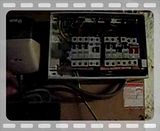I often hear such suggestions, but have you any idea how that could cause sn RCD to operate (particularly when, as is presumably the case here, little or no current is being switched)? I personally really can't think of a mechanism that could cause this to happen.Sounds like a bit of a poor contact when the switch is closing. You could try a different switch for a bit and see if the problem disappears.
Kind Regards, John
I know it's not the best video, as it was taken on my very old phone, but here's a neutral cable which had a bit of a high resistance joint. Who can explain this then?


